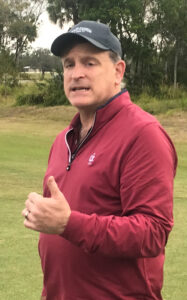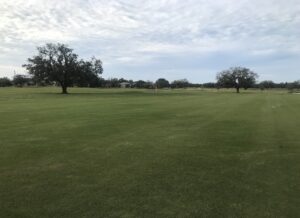Bobby Jones is now a fairway, plus park and wetlands.
By Johannes Werner
Original Air Date: Dec. 13, 2023
Host: In case you missed it: This morning was the official reopening of the Bobby Jones golf course and park, after extensive renovations. The 90-acre park component is really the new aspect of what is the biggest contiguous piece of green land within City of Sarasota limits. It’s a 300-acre green lung surrounded by suburbs, and it now includes restored wetlands that can serve as a sponge for floods. Our news team took a tour.
[sand blower sound]
Johannes Werner: That’s the sound of maintenance workers getting rid of sand on golf greens. The last-minute cleaning was happening ahead of a grand opening of the Bobby Jones golf course and park on a windy and gray morning. The official opening comes after the biggest chunk of a $20 million renovation has been completed, after one-and-half years of work. Two-dozen shiny new golf carts were neatly lined up in front of the portable that serves as the golf course office until a new, two-story club house is completed.
 Bobby Jones — named after a popular golf pro of the 1920s and 30s — is a nearly century-old landmark. Designed by legendary fairway architect Donald Ross and opened in 1927, the course was redesigned by Richard Mandell with Ross’ original intent in mind. The city decided to shrink the course from 36 holes to 27, plus a driving range. That, in turn, made it possible to add the natural preserve and park component.
Bobby Jones — named after a popular golf pro of the 1920s and 30s — is a nearly century-old landmark. Designed by legendary fairway architect Donald Ross and opened in 1927, the course was redesigned by Richard Mandell with Ross’ original intent in mind. The city decided to shrink the course from 36 holes to 27, plus a driving range. That, in turn, made it possible to add the natural preserve and park component.
The day before the opening, the City of Sarasota, which owns what Mayor Liz Alpert called the city’s Central Park, had invited media for a pre-opening tour.
Most of the attention during the media tour was on the completely redesigned golf course. Deservedly so, an expert said. I asked the editor of Golf Course Industry magazine why he flew in for the occasion from Ohio. Guy Cipriano called Bobby Jones a “super big deal for golf” – because it sets a signal for the post-pandemic recovery of the sport, because it’s a high-profile example of the renovation trend for golf courses, and because it’s municipally owned.
So what’s this $20 million investment good for most of us residents who don’t play golf? For one, the intent for this course is to make golfing more affordable and accessible. The city contracted a subsidiary of Troon Golf — the worldwide biggest club manager — to run the course. Troon says it will work with local schools to promote the sport. Residents get a 40% discount, which should bring the cost of a round to somewhere near $60.

Richard Mandell. Photos: Werner
 If that is still too steep for you, city officials emphasize that this is a park for everyone, and there’s no fee to enter. Walkers and bikers can enjoy from dusk to dawn the open-horizon vistas sprinkled with Spanish-moss bearing grand oak and banyan trees. The park offers two miles of marked trails, and 90 acres of the land is now a natural preserve, most of which is wetlands sprinkled with ponds. Wading birds were staking out the newly dug water bodies during the tour.
If that is still too steep for you, city officials emphasize that this is a park for everyone, and there’s no fee to enter. Walkers and bikers can enjoy from dusk to dawn the open-horizon vistas sprinkled with Spanish-moss bearing grand oak and banyan trees. The park offers two miles of marked trails, and 90 acres of the land is now a natural preserve, most of which is wetlands sprinkled with ponds. Wading birds were staking out the newly dug water bodies during the tour.
Course designer Richard Mandell explained how they redesigned the land to absorb water during storms.
Richard Mandell: We have a 90-acre park, and we’ve got Philippi Creek – Philippi Main Canal – that runs along Circus Boulevard. And there’s another canal that cuts through the golf course. Generally speaking, we created a 22-acre wetland to slow water down, doing water quality and water quantity from the north of the property through the property so that we clean up the water, slow water down for flood situations, before the water gets to the Bay.
JW: Mandell suggests that the times are over when golf courses turned land into drained swamps and toxic brownfields.
RM: They’re really one and the same, when I think about golf and stormwater, because people have said before golf is drainage, drainage, drainage. And [Bobby Jones] is a great example of how golf and the environment work together.
JW: There’s no need to take your car to get to the park. Bobby Jones will be connected to the Legacy Trail in the near future, making it a potential destination for bicyclists.
Asked whether there’s a chance the city may extend its free Bay Runner trolley service from the beaches and downtown, to run along Fruitville Road to the park, Alpert cautioned that may be too costly.

Liz Alpert
Since we’re talking about cost: Back to finances. The city pays the Troon subsidiary $10,000 a month to manage the course. The contractor, in turn, says it designed its golfing fees trying to strike a balance between accessibility and being sufficiently profitable to service the $20 million debt, and build reserves for future maintenance work.
Although financial pressures were a constant during the planning of the Bobby Jones restoration, city commissioners and engaged residents managed to prevent this green lung from turning into yet another piece of luxury real estate. Asked by WSLR News, Mayor Alpert suggested critics set the bar of financial expectations for the city too high.
Liz Alpert: Some people suggested we should sell [Bobby Jones] to developers, or at least half of it, the part that’s nature …, and make a profit. … There was a lot of pushback about how much it was going to cost and whether the city could recover that or not. But we are fairly confident that we can make a profit. But even if we don’t: What park has to pay for itself?
JW: This has been Johannes Werner, reporting for WSLR News.
WSLR News aims to keep the local community informed with our 1/2 hour local news show, quarterly newspaper and social media feeds. The local news broadcast airs on Wednesdays and Fridays at 6pm.